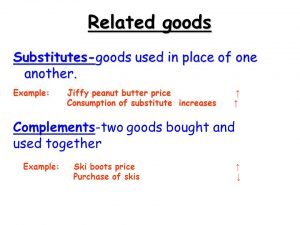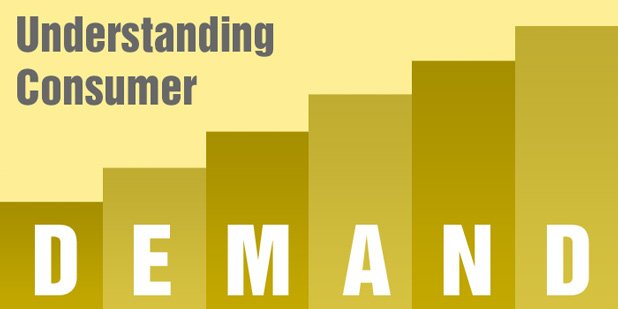Why do organizations know about determinants of demand?
Willingness to buy and ability to pay for a product or service can create sales which result in demand, there are various factors which affect the demand for a particular product. According to the law of demand, there exists a relation between price and demand. If the price decreases then the demand increases and if the price increases then the demand decreases. So price is the main factor which influences demand. But some other factors also show the effect on the changes in the demand. Such as income levels of the buyers, prices of related goods i.e. substitute and complementary goods, changing tastes and preferences of the customers, differences in wealth, population, expectations, Government policies, seasonal variations, economic conditions. So the factors may be economic, political, social, demographic or environmental, thus knowing these factors are essential for the creation of sales and profits.

Price of the product
Price is the most important factor, which directly influences the demand, here price fluctuations cause the fluctuations in the demand which may on the entire sales or quantity purchased by a single consumer. The demand created at a particular price is termed as price demand where an increase in price causes decrease in demand and decrease in price causes increase in demand. For example, if the price of the gold increases then the quantity demanded becomes less. But there are some exceptions regarding the law of demand, here in the case of various necessaries such as milk, bread, rice, vegetables, etc. the demand does not differ much.
Consumer’s income levels
Increase income levels of the buyers result in increase or decrease in demand for the products or services.
Normal goods
Demand increases with the increase in income levels of the buyers. For example increase in income of buyers makes them buy branded products instead of non-branded products.
Inferior goods
In the case of inferior goods, demand decreases with the increase in income. Here willingness to buy makes the buyers purchase varieties of goods with higher prices due to the increase in income levels. So the consumers shift to high quality and high priced goods, these are also called as Giffen goods.
Prices of the related goods:
Prices of the related goods show influence on the demand conditions of a particular product. Here the related goods are substitute goods and complementary goods.

Substitute products
Substitute products can satisfy the same consumer needs or they can give similar benefits. The increase in the availability of the substitutes results in the increase in competition because the increase in the price of a product results in the increase in demand for the substitute products. Various factors influencing the demand for substitute products are the change in customer’s tastes and preferences increase in prices of the products, quality, performance and availability of the substitute products, etc. So the organizations should play strategies while taking pricing decisions, otherwise, it may give negative results.
Complementary goods
Complementary good is a product, which has only a little value or no value when it is used without its related products. The increase in the demand for complementary goods creates demand to the products related to it. The demand of complementary goods is directly proportional to each other. For example increase in the demand of bread results in the increase in the demand for butter and jam. So these products create value to their related products. So the marketers should always follow the market conditions and prices of the related goods for fixing the prices and to make changes in the production levels.
Tastes and preferences

Due to the globalization and internet usage, make the customers aware of the wide varieties of the products and substitute products also; it makes them pick a single product from the bulk with a simple access, so knowing the changes in tastes and preferences of the customers is becoming a challenge to the marketers. Increase in willingness to buy a product increases the demand for the products and its complementary products also. So the customer’s preference is also one of the main factors which rule the market demand.
Economic conditions
Economic conditions of the country enable the marketers to know about their product’s future demand. Per capita income determines the economic conditions of the country, in such conditions demand varies directly proportional to each other. If a country’s economic condition is in a boom then the demand for superior goods increases. So the wealth of the country tells the future demand for the products and services and the location of product launching is an important thing to maximize the demand and sales.
Population
The increase in the population of a particular geographic location shows influence on the demand conditions. If a country’s population is high then it creates demand for necessaries. Variations in the demographic composition also show a major influence on the particular product’s demand. The ratio of the demographic composition such as age, gender, income, and education etc shows an effect on the demand for various commodities.
Climate and seasonal variations
Companies should not come to a conclusion with the increase in demand for a product at a particular geographical area during particular weather conditions. Though the organizations aware of it also, fluctuations in environmental conditions and uncertainty make them take wrong decisions such as increase or decrease in production and extent of advertisements etc.
Government policies
Government policies show major influence on the demand, if the tax on a particular product is increased, then the organizations should increase the price, otherwise, they may not survive, in such conditions customers search for substitute products which result in the decrease in demand or severe losses. On the other hand, some government policies encourage the small business and new entrants by giving subsidies and tax reductions, it enables the organizations to produce low priced products it creates an increase in demand.
Organizations should know about the various factors which influence the sales and demand, some of them are discussed as follows.
Price is the most important factor which shows direct influence on the demand. While taking pricing decisions managers should consider the substitute product’s availability, nature of the product, competitor’s prices, day to day market conditions etc. A slight change in the price can also make a major difference in the demand for the products and services.
Buyer’s income levels show a major effect on the demand, with the increase in income levels demand for certain goods reduces, so the organizations should aware of this concept. But how they will survive? Here, the increase in income levels of all the customers do not occur overnight, so it enables the organizations to modify the existed products and playing various marketing strategies. But the thing to remember is regular market research.
In general, demand decreases with the increase in prices, but some organizations play a strategy with the customer’s perception and belief. Customers buy some products and services even at higher prices also, the reason behind is perception and way of thinking, they believe that high-priced products are qualitative and superior. Likewise, they believe that the low-priced products are quality less or least durable. So while fixing prices customer’s perception and variations in demand should be taken into the consideration.
Sometimes demand increases with the increase in prices; this is an exception to the law of demand which occurs due to the speculative effect.

For example with the increase in prices of gold, demand also increases. Here consumer’s perception and belief play a major role in creating demand, this is because customers think that prices increase still further. So with the proper study of the markets only marketers should come to the production decisions, here in this condition companies can increase the production level with the increase in prices.




